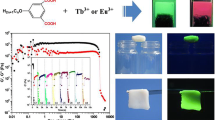Abstract
We report an original way to prepare luminescent glass–ceramic microrods containing Eu3+ doped BaF2 nanocrystals by sol–gel chemistry within the pores of a polycarbonate template membrane. Structural characterization by scanning electron microscopy and X-ray diffraction has shown the formation of glass–ceramic microrods with 0.8-m diameter of and 10 μm length in which BaF2 nanocrystals of about 30 nm size are embedded. Photoluminescence measurements have indicated the incorporation of Eu3+ ions inside the BaF2 nanocrystals in a broad range of sites with low coordination symmetry. The comparison made with the bulk glass–ceramic indicated an influence of the dimensional constraints imposed by the membrane pores during xerogel formation and subsequent glass ceramization.





Similar content being viewed by others
References
Binnemans K, Görller-Walrand C (1996) Application of the Eu3+ ion site symmetry determination. J Rare Earths 14:173
Cao G, Liu D (2008) Template-based synthesis of nanorod, nanowire, and nanotube arrays. Adv Colloid Interface Sci 136:45–64
Chen D, Wang Y, Yunlong Yu, Ma En, Zhou L (2006) Microstructure and luminescence of transparent glass–ceramic containing Er3+:BaF2 nano-crystals. J Solid State Chem 179:532–537
Clara Gonçalves M, Santos Luís F, Almeida Rui M (2002) Rare-earth-doped transparent glass ceramics. CR Chim 5:845–854
Dejneka MJ (1998) The luminescence and structure of novel transparent oxyfluoride glass–ceramics. J Non Cryst Solids 239:149–155
del-Castillo J, Yanes AC, Mendez-Ramos J, Tichomirov VK, Rodríguez VD (2009) Structure and up-conversion luminescence in sol–gel derived Er3+–Yb3+ co-doped SiO2:PbF2 nano-glass–ceramics. Opt Mater 32:104–107
Devlin K, O’Kelly B, Tang ZR, McDonagh C, McGilp JF (1991) A structural study of the sol–gel process by optical fluorescence and decay time spectroscopy. J Non Cryst Solids 135:8–14
Dorenbos P (2003) Systematic behaviour in trivalent lanthanide charge transfer energies. J. Phys Condens Matter 15:8417–8434
Driesen K, Tikhomirov VK, Görller-Walrand C (2007) Eu3+ as a probe for rare-earth dopant site structure in nano-glass–ceramics. J Appl Phys 102:024312
Fujihara S, Tokumo K (2009) Chemical processing for inorganic fluoride and oxyfluoride materials having optical functions. J Fluor Chem 130:1106–1110
Fujihara S, Mochizuki C, Kimura T (1999) Formation of LaF3 microcrystals in sol–gel silica. J Non Cryst Solids 244:267–274
Gallagher PK (1964) Absorption and fluorescence of europium (III) in aqueous solutions. J Chem Phys 41:3061–3064
Lakshmi BB, Dorhout PK, Martin CR (1997) Sol–gel template synthesis of semiconductor nanostructures. Chem Mater 9:857–862
Nogami M, Abe Y (1996) Properties of sol gel-derived Al2O3–SiO2 glasses using Eu3+ ion fluorescence spectra. J Non Cryst Solids 197:73–78
Rodnyi PA, Khodyuk IV, Stryganyuk GB (2008) Location of the energy levels of the rare-earth ions in BaF2 and CdF2. Phys Solid State 50:1639–1643
Santana-Alonso A, Mendez-Ramos J, Yanes AC, del-Castillo J, Rodríguez VD (2010) Up-conversion in sol–gel derived nano-glass–ceramics comprising NaYF4 nano-crystals doped with Yb3+, Ho3+ and Tm3+. Opt Mater 32:903–908
Secu M, Secu CE, Ghica C (2011a) Eu3+-doped CaF2 nanocrystals in sol–gel derived glass–ceramics. Opt Mater 33:613–617
Secu CE, Secu M, Ghica C, Mihut L (2011b) Rare-earth doped sol–gel derived oxyfluoride glass–ceramics: structural and optical characterization. Opt Mater 33:1770–1774
Secu CE, Polosan S, Secu M (2011c) Magneto-optical investigations of rare earth doped sol–gel derived silicate xerogels. J Lumin 131:1747–1752
Acknowledgments
We acknowledge the financial support by the Romanian Education and Research Ministry (IDEI Project No. 290/05.11.2011).
Author information
Authors and Affiliations
Corresponding author
Rights and permissions
About this article
Cite this article
Secu, M., Secu, C.E. & Sima, M. Sol–gel template synthesis of luminescent glass–ceramic rods. J Nanopart Res 14, 772 (2012). https://doi.org/10.1007/s11051-012-0772-1
Received:
Accepted:
Published:
DOI: https://doi.org/10.1007/s11051-012-0772-1




